Hallberg-Rassy 33 Mistral
Sailboat specifications
The Hallberg-Rassy 33 Mistral is a 33’5” (10.18m) cruising sailboat designed by Olle Enderlein (Sweden). She was built between 1966 and 1975 by Hallberg-Rassy (Sweden) with 216 hulls completed.
Hallberg-Rassy 33 Mistral's main features
- Model
- Hallberg-Rassy 33 Mistral
- Hull type
- Monohull
- Category
- Cruising sailboat
- Sailboat builder
- Sailboat designer
- Country
- Sweden
- Construction
- GRP (glass reinforced polyester):
- Hull: Single skin fiberglass polyester
- Deck: Sandwich fiberglass polyester - Number of hulls built
- 216
- First built hull
- 1966
- Last built hull
- 1975
- Appendages
- Keel : fin without bulb
- Helm
- Single tiller (helm wheel in option)
- Rudder
- Single rudder on skeg
- Unsinkable
- No
- Trailerable
- No
- Standard public price ex. VAT (indicative only)
- N/A €
Hallberg-Rassy 33 Mistral's main dimensions
- Hull length
- 33’ 5”10.18 m
- Waterline length
- 25’ 1”7.65 m
- Beam (width)
- 9’ 11”3.02 m
- Draft
- 4’ 10”1.47 m
- Mast height from DWL
- 45’ 4”13.8 m
- Light displacement (MLC)
- 11464 lb5200 kg
- Ballast weight
- 5291 lb2400 kg
Hallberg-Rassy 33 Mistral's rig and sails
- Upwind sail area
- 587 ft²54.5 m²
- Downwind sail area
- 1028 ft²95.5 m²
- Mainsail area
- 221 ft²20.5 m²
- Genoa area
- 366 ft²34 m²
- Jib area
- 188 ft²17.5 m²
- Symmetric spinnaker area
- 807 ft²75 m²
- Rigging type
- Ketch Marconi masthead
- Mast configuration
- Deck stepped mast
- Rotating spars
- No
- Number of levels of spreaders
- 1
- Spreaders angle
- 0 °
- Spars construction
- Aluminum spars
- Standing rigging
- 1x19 strand wire continuous
Hallberg-Rassy 33 Mistral's performances
- Upwind sail area to displacementiThe ratio sail area to displacement is obtained by dividing the sail area by the boat's displaced volume to the power two-thirds.
The ratio sail area to displacement can be used to compare the relative sail plan of different sailboats no matter what their size.
Upwind: under 18 the ratio indicates a cruise oriented sailboat with limited performances especially in light wind, while over 25 it indicates a fast sailboat. - 195 ft²/T18.16 m²/T
- Downwind sail area to displacementiThe ratio sail area to displacement is obtained by dividing the sail area by the boat's displaced volume to the power two-thirds.
The ratio sail area to displacement can be used to compare the relative sail plan of different sailboats no matter what their size. - 343 ft²/T31.82 m²/T
- Displacement-length ratio (DLR)iThe Displacement Length Ratio (DLR) is a figure that points out the boat's weight compared to its waterline length. The DLR is obtained by dividing the boat's displacement in tons by the cube of one one-hundredth of the waterline length (in feet).
The DLR can be used to compare the relative mass of different sailboats no matter what their length:
a DLR less than 180 is indicative of a really light sailboat (race boat made for planning), while a DLR greater than 300 is indicative of a heavy cruising sailboat. - 329
- Ballast ratioiThe Ballast ratio is an indicator of stability; it is obtained by dividing the boat's displacement by the mass of the ballast. Since the stability depends also of the hull shapes and the position of the center of gravity, only the boats with similar ballast arrangements and hull shapes should be compared.
The higher the ballast ratio is, the greater is the stability. - 46 %
- Critical hull speediAs a ship moves in the water, it creates standing waves that oppose its movement. This effect increases dramatically the resistance when the boat reaches a speed-length ratio (speed-length ratio is the ratio between the speed in knots and the square root of the waterline length in feet) of about 1.2 (corresponding to a Froude Number of 0.35) . This very sharp rise in resistance, between speed-length ratio of 1.2 to 1.5, is insurmountable for heavy sailboats and so becomes an apparent barrier. This leads to the concept of "hull speed".
The hull speed is obtained by multiplying the square root of the waterline length (in feet) by 1.34. - 6.71 knots
Hallberg-Rassy 33 Mistral's auxiliary engine
- Engine(s)
- 1 inboard engine
- Engine(s) power
- 25 HP
- Fuel type
- Diesel electric
- Fuel tank capacity
- 26.4 gal100 liters
Hallberg-Rassy 33 Mistral's accommodations and layout
- Cockpit
- Closed aft cockpit
- Cabin(s)
- 1
- Berth(s) (min./max.)
- 5 / 6
- Head(s)
- 1
- Freshwater tank capacity
- 26.4 gal100 liters
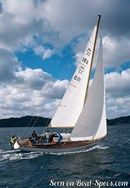

Hallberg-Rassy 33 Mistral - - 1/12
Picture extracted from the commercial documentation © Hallberg-Rassy
Picture extracted from the commercial documentation © Hallberg-Rassy
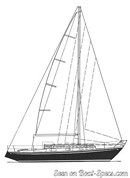

Hallberg-Rassy 33 Mistral sailplan - - 2/12
Picture extracted from the commercial documentation © Hallberg-Rassy
Picture extracted from the commercial documentation © Hallberg-Rassy


Hallberg-Rassy 33 Mistral layout - - 3/12
Picture extracted from the commercial documentation © Hallberg-Rassy
Picture extracted from the commercial documentation © Hallberg-Rassy


Hallberg-Rassy 33 Mistral layout - - 4/12
Picture extracted from the commercial documentation © Hallberg-Rassy
Picture extracted from the commercial documentation © Hallberg-Rassy


Hallberg-Rassy 33 Mistral layout - - 5/12
Picture extracted from the commercial documentation © Hallberg-Rassy
Picture extracted from the commercial documentation © Hallberg-Rassy
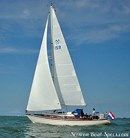

Hallberg-Rassy 33 Mistral sailing - - 6/12
Picture extracted from the commercial documentation © Hallberg-Rassy
Picture extracted from the commercial documentation © Hallberg-Rassy


Hallberg-Rassy 33 Mistral sailing - - 7/12
Picture extracted from the commercial documentation © Hallberg-Rassy
Picture extracted from the commercial documentation © Hallberg-Rassy


Hallberg-Rassy 33 Mistral sailing - - 8/12
Picture extracted from the commercial documentation © Hallberg-Rassy
Picture extracted from the commercial documentation © Hallberg-Rassy
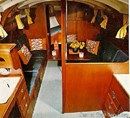

Hallberg-Rassy 33 Mistral interior and accommodations - - 9/12
Picture extracted from the commercial documentation © Hallberg-Rassy
Picture extracted from the commercial documentation © Hallberg-Rassy


Hallberg-Rassy 33 Mistral interior and accommodations - - 10/12
Picture extracted from the commercial documentation © Hallberg-Rassy
Picture extracted from the commercial documentation © Hallberg-Rassy
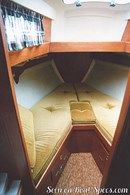

Hallberg-Rassy 33 Mistral interior and accommodations - - 11/12
Picture extracted from the commercial documentation © Hallberg-Rassy
Picture extracted from the commercial documentation © Hallberg-Rassy


Hallberg-Rassy 33 Mistral interior and accommodations - - 12/12
Picture extracted from the commercial documentation © Hallberg-Rassy
Picture extracted from the commercial documentation © Hallberg-Rassy
Similar sailboats that may interest you:
Sailboats
First built hull
Hull length
1967
34’ 5”10.5 m
1986
30’ 11”9.42 m
1991
34’ 4”10.44 m
1971
31’ 2”9.5 m
1972
31’ 2”9.5 m
1971
30’9.14 m
1981
32’ 5”9.87 m
1970
33’ 8”10.26 m
1986
29’ 11”9.12 m
1985
32’ 10”10 m
1979
33’10.06 m
1969
25’ 11”7.9 m
1967
33’ 1”10.1 m
1978
34’ 7”10.54 m
2006
34’ 10”10.6 m